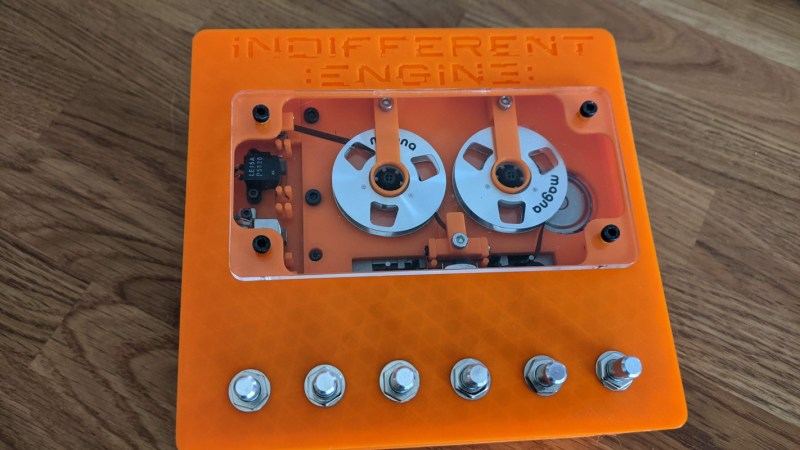Modern popular music increasingly relies on more and more complicated and intricate equipment and algorithms to generate catchy tunes, but even decades ago this was still the case. The only difference between then and now was that most of the equipment in the past was analog instead of digital. For example, the humble tape echo was originally made by running a loop of magnetic tape over a recording head and then immediately playing it back. Old analog machines from that era are getting harder and harder to find, so [Adam Paul] decided to make his own.
At first, [Adam] planned to use standard cassette tapes in various configurations in order to achieve the desired effect, but this proved to be too cumbersome and he eventually switched his design to using the cassette internals in a custom tape deck. The final design includes a small loop of tape inside of the enclosure with a motor driving a spindle. The tape is passed over a record head, then a read head, and then an erase head in order to achieve the echo sound. All of this is done from inside of the device itself, with 1/4″ jacks provided so that the musician can plug in their instrument of choice just like a standard effects pedal would be configured.
The entire build is designed to be buildable and repairable using readily-available parts as well, which solves the problem of maintaining (or even finding) parts from dedicated tape echo machines from decades ago. We like the sound from the analog device, as well as the fact that it’s still an analog device in a world of otherwise digital substitutes. Much like this magnetic tape-based synthesizer we featured about a year ago.
















Cool!
We need to sees the inside. Where is da inside?
I haven’t finished writing it up (or developing it) yet. Almost there, want to do another rev of the PCB to tidy up some stuff. Then I’ll post exploded views of the CAD files, gut shots and STLs and what not.
Cool…In the 70s, I toured with a band that had an analog keyboard instrument called a Mellotron that was basically a rack of spring loaded tapes that fed past a rack of read heads with a keyboard to engage the drive rollers..
Funny you should mention, I’m part way through a build for a cassette synth based on this same idea. It uses some of the same parts as the echo.
DUUUUUUDE! This sounds wicked. I can’t wait to see how this comes out… even a RZ1 style, mellotron-esque drum machine would be super sick
Very very interesting. Many (most?) analog tape echoes use several playback heads to get more variations of echo sound. I also got a tape echo where one of the playback heads can be moved around to change the timing.
Yea it might be cool to stick more heads in different positions for more possibilities – it’d just be a matter of figuring out where there’s space to put them and rigging up a switch to switch between them. The slide-able one sounds interesting, I’ll have a think about how that might work. What’d be super neat is a head that can be slid back and forth along a rail by the Arduino to add weird oscillations in pitch to the echoes.
If you slowly move one head back and forth and mix the signal with the one from a fixed head (or one moving at different speed) you get the chorus effect by simulating a slight detune between two copies of the same signal. The detuning is obtained because the moving head speed is added to or subtracted from the tape speed, therefore the signal is actually read at different speeds. A servo driven by a slow sine or triangle wave to move the head is a good starting point; damping the servo vibrations so that they don’t get into the sound will probably be the hardest part.
The more heads moving at different speeds, the more rich the sound becomes, and more difference in speed will make the signals out of tune therefore widening the effect even more, until the point they’re so much out of tune to become uncomfortable to listen to. It’s a really nice effect, though not easy to do mechanically, especially with more than one moving head involved.
If you have the sequence record head, play head, erase head, capstan, then you can place a pawl between record head and play head to pull the tape and extend the distance (and time) between record and play. This would also make some interesting effects for sampling.
This whole thing can be simplified mechanically. The only critical component is the capstan. Have a look at old telephone company “recorded voice announcement” machines. The tape just spools on a flat surface with no guides or rollers.
https://hackaday.com/2021/07/18/the-hidden-sounds-of-the-past/
Yea that’s nice. Certainly the reels in this design perform no function other than to look cool and can be left out. I did have a lot of success with printing my own pinch roller so I’ll return to that once I finalise this current ‘based on a cassette player’ design. I’m interested to see whether the simple “tape loop slab with a pinch roller” prototype I made will work well now that I have ‘finalised’ electronics. (this thing https://youtu.be/vcAF6XuIq8I )